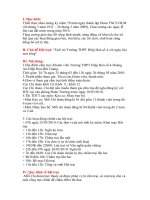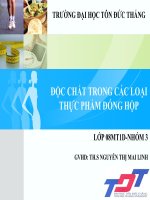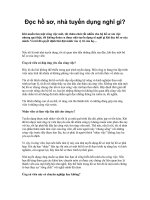Customer relationship crm tài liệu đọc
Bạn đang xem bản rút gọn của tài liệu. Xem và tải ngay bản đầy đủ của tài liệu tại đây (1.2 MB, 5 trang )
Customer Relationship-CRM
Lecturer: Chương
Chapter 1: Introduction
CRM (software)- all aspects of company interaction with customers including
prospecting (tim KH), sales and service
provide insight and improve the company/customer relationship
CRM is a biz strategy
→ maximizes profitability, revenue and cuz satisfaction
→ fostering behavior that satisfies cuz
→ implementing customer-centric processes
Four types of CRM
type of CRM
Dominant characteristics
Strategic
chỉ tập trung vào khách hàng chiến lược (core customer-centric)
Operational
automation of customer-facing processes such as selling, marketing,
and customer service
Analytical
intelligent mining of customer-related data for strategic or tactical
purposes → có cảm tình hay ác cảm để thay đổi chương trình quảng
bá
Collaborative nội bộ
có những phịng ban khơng hợp tác với nhau để giành nguồn tài
nguyên
Customer centricity and other business logics 1
1_Product-oriented (nhóm DN chỉ quan tâm đến sản phẩm): Biz believe that
customers choose product with the best quality, performance, design or
features
2_Production-oriented: Biz believe that customers choose low-price products
3_Sales-oriented: Cuz will be persuaded to buy by advertising, selling, public
relations and sales promotion
Customer Relationship-CRM
1
4_A customer or market-oriented: It uses cuz and competitive in4 to develop
better value propositions for cuz. It constantly adapts to customers requirements
and competitive conditions.
putting customer first
OPERATIONAL CRM
Marketing automation
Market segmentation
Campaign management
Event-based (trigger) marketing
Sales force automation
account management , lead management , opportunity management, pipeline
management, contact management, quotation and proposal generation, and
product configuration
Service automation
case (incident or issue) management
inbound communication management
queuing and routing
service level management
SOURCES OF CUSTOMER-RELATED DATA FOR
ANALYTICAL CRM
INTERNAL SOURCES
sales data (purchase history)
financial data (payment history, credit score)
marketing data (campaign response, loyalty scheme data)
service data
EXTERNAL SOURCES
Geo-demographic and life-style data from business intelligence organisations
BENEFICIALRIES OF ANALYTICAL CRM
Customer Relationship-CRM
2
CUSTOMER
analytical CRM can deliver timely, customized, solutions for cus’s problems
enhancing satisfaction
⇒
COMPANY
offers the prospect of more powerful cross-selling and up-selling
Cross-selling (Bán kèm) involves selling related, supplementary products or
services based on the customer's interest in, or purchase of, one of your
company's product
Up-selling
IDIC model of CRM
Identify who your customer are and build a deep understanding of them
Differentiate your customers to identify which customers have most value now
and which offer most for future
⇒
Interact
understand customer expectation and their relationship with other
suppliers or brands
⇒
Customize
offer and communications to ensure that the expectation of
customers are met
MISUNDERSTANDING ABOUT CRM
database marketing, marketing process, an IT issue, loyalty scheme, it can be
conducted by any company
MODEL OF CRM
Customer Relationship-CRM
THE CRM value chain
3
the QCi
Gartner’s competency model
of CRM
CHỊ NGÂN
Payne’s 5-process model of
CRM
/>
VINAMILK
GRAB
/> />
Customer Relationship-CRM
4
Customer Relationship-CRM
5






![Tài liệu [DOC] Bài tập nhóm số 2 mẫu môn học Tài Chính](https://media.store123doc.com/images/document/13/ve/ik/medium_hOywzZYBxw.jpg)


